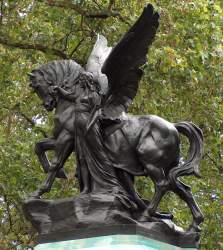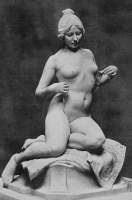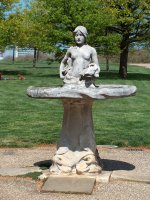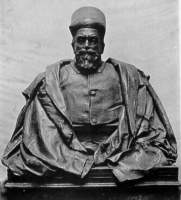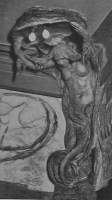William Robert Colton (1867-1921)
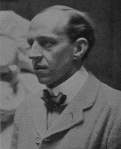
W. R. Colton.
“There is apparent in [all his later productions] a certain love of picturesqueness – of a sort of pictorial freedom as opposed to sculptorual severity – which influences both the character of his main design and the management of the details by which this design is amplified and completed. He has a liking for free and flowing line, for compositions which are complicated and elaborate, and for form arrangements whcich can be made sumptuous without becoming unduly involved. This liking is evident all through his work…”
The Artillery Memorial (Boer War), by Colton.
The sculptor W. R. Colton’s best known work today, though few would be aware who made it, is the Boer War Memorial to the Royal Artillery on the Mall, to the north side of St James’s Park in London. He has other war memorials among his oeuvre, a variety of allegorical and ideal nudes, figures of children, some portrait statues and busts, and as a New Sculptor working in the 1900s, an amount of decorative work on a large and small scale.
Colton was born in Paris, but came to England at a young age and studied at the Lambeth School under W. S. Frith, and then at the Royal Academy from 1889, being taught by Edgar Boehm and H. H. Armstead. He also spent a period back in Paris. However, he made his home in London, with his studio in Eaton Terrace, near Victoria, from 1895 to after 1913, and also had an address in St Mary Abbot’s Place in Kensington from about that latter date.
He was elected Associate of the Royal Academy in 1903, taught there from the following year, later becoming Professor of Sculpture from 1907-11, and became full RA in 1919. He died relatively young just two years later.
The Girdle.
He achieved success with The Girdle, exhibited in 1898, a seated nude in the French fashion, engaged in perhaps the earliest stage of attiring herself – this work was bought under the terms of the Chantrey Bequest. Other nude figures followed - indeed, he was at one time criticised for being 'often realistic, and sometimes in danger of suggesting mainly studies of the nude'. His work in this vein included, with varying degrees of subject and allegory, the strange The Image Finder of 1899, The Crown of Love dating from 1900 showing a couple with their hair mingling (it is compared with other allegorical representations of Love on this page), The Wavelet in 1901, showing a young girl or sprite on a rock above the water, and The Spring Tide of Life, a group of two children, in 1902. Other works, from his early The Prevailing Light of 1895 through to In Borrowed Plumes of 1916 depicting a nude with hat and one sandal, continue the somewhat coquettish theme, this last recalling to mind the nymphs of the genre painter Arthur Hacker.
Colton’s most exquisite figure, though, by far, is the sculptural group of a winged angel leading a horse as the main sculpture of the Royal Artillery Boer War Memorial (completed 1902) on the north side of St James’s Park. This must rank as one of the foremost sculptural groups in London. The horse trots forward and upward, accompanied by the proud female figure of the angel, rather a Valkyrie, her long skirt trailing backwards, echoed by her long tresses of hair, her wings proudly erect. There are reliefs on the stone memorial below, and a procession of mounted troops in a frieze around the central plinth. The whole monument is to the design of the architect Aston Webb.
His other war memorials include the Worcester Boer War Memorial (pictured on this page), the Staffordshire County War Memorial (1923, completed posthumously by Merrifield) showing a horse and an angel, and a couple of memorial plaques in churches including one to William Thomas Wyllie (d 1916) in Portsmouth Cathedral, which I have not seen, and in the Natural History Museum on the main stairway leading up from the Diplodocus hall, a memorial to Capt. F. C. Selous (d 1917) with a portrait half-statue and, underneath, a plaque showing basking lions.
Hyde Park fountain.
One other public work by Colton is his Hyde Park Mermaid Fountain, commissioned when ‘through some delightful aberration still unexplained or at least unreported on the part of the Government, the First Commissioner ventured into art patronage’. It seems to have been rechristened as 'Little Nell' at some later date (at least I have not seen this appellation in contemporary descriptions). The work we see today (or saw) is a copy put up in 1975 apparently to replace the original of about 1897, with something of a loss to the base at least, but I liked it nevertheless. Alas, even this disappeared some time in summer 2011, after some vandalism earlier in the year or perhaps in the previous winter.
Maharajah of Mysore, and S. N. Tata of Bombay.
Among Colton’s portrait works, notable are a high relief portrait of E. J. Poynter PRA, busts of Henry Woods RA and his one-time teacher the sculptor H. H. Armstead RA (the latter in the Royal Academy collection), a small version for a portrait statue of the young Disraeli, very dashing, which I think was never executed, a statuette of Edward VII enthroned, and some charming child portrait busts, including a Diana which was his diploma work for the Royal Academy. Important in his career was a series of Indian portraits in the mid-1900s, including statues and busts of the Maharajah of Mysore and the Dewan of Mysore, and a monument to J. Tata, including allegorical figures, for Bombay.
We should also mention some decorative work produced by Colton, an example in plaster being shown below.
